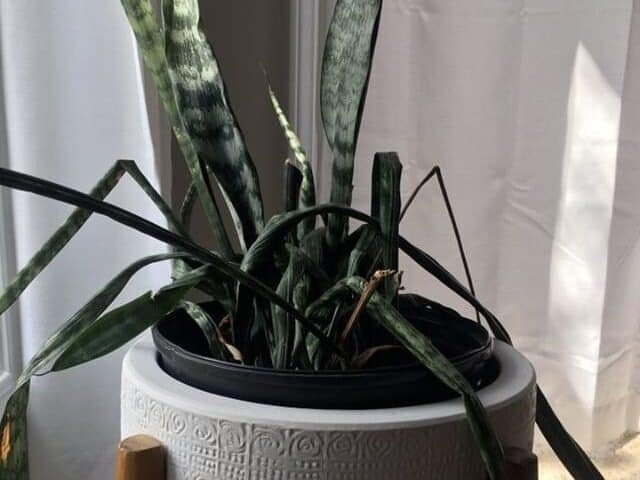Watering Snake Plant

Snake plant leaves can shrivel if water is applied incorrectly, causing them to lose their vibrant color.
Snake plants (Sansevieria) will thrive when you handle them lightly. They don’t require a lot of water, and they actually flourish when you let them dry out in between waterings.
Here we will cover all the necessary information regarding watering Sansevieria at home, including when to water, how to water, and considerations regarding light, temperature, soil, and the seasons.
How to Water Snake Plants?
During the summer, or when the top 2/3 of the soil becomes drier, hydrate the snake plant with dechlorinated tap water or filtered water once the soil is fully hydrated. The higher the temperatures, and the more sunlight, the more water they require.
Considering Factors
Temperature & Humidity
Snake plants lose considerable amounts of water through transpiration in high-temperature areas. Therefore, you will have to water your plant more at warmer temperatures than you would at lower temperatures.
Dry air also causes your plants to transpire more than humid air. So, if the air is dry, you’ll need to fertilize and water more often.
Snake plants require longer, less intense periods of illumination to survive. However, they can survive in dark areas or under indirect light.
Season
Because of the reduced amount of light, many snake plants in the winter slow down their growth, so they do not require as much water.
Snake plants begin to grow again and use more water as the days lengthen.
With a grow light providing constant light throughout the year, the seasons will have little effect on how much you have to water your snake plant.
Soil Mix
Your snake plant needs to be planted in a well-draining soil blend when it can run off the excess water. If you’re using a poorly draining mixture, you’ll need to water it less. The best thing to do is switch to a better blend.
There will always be difficulty finding a balance here – large snake plants typically need more water than smaller snake plants, as might be expected, but larger plants are typically in larger containers.
In addition, watering a larger plant more frequently might not mean the same as watering a small plant often. Instead, larger plants need more water with each watering.
Watering smaller containers more often will be necessary because the soil dries out faster than in larger containers. But, you do not need to use a large volume of water during each watering.
The type of pot also has an impact on how often you’ll need to water them. Terracotta pots draw water out of the soil faster, so plants in terracotta pots need to be watered more often than plants in ceramic or plastic pots.
We have an article about the type of pot for snake plant in our blog: Go to: What Type Of Pot For Snake Plant? Your Choice Matters!
When Should I Water My Snake Plant?
The best rule to follow is that when the snake plant’s top 2/3 of its soil dries out, watering is needed. You can check the moisture level of the soil with your finger.
In addition, you can also use a moisture meter to check the soil. When the meter reads 2 on a scale of 1-10, it is time to water.
How Often Should I Water My Snake Plant?
In addition to considering the factors listed above, you can also use the following estimates when determining how often to water your snake plant.
In the spring, slowly increase the frequency of watering your plant every two to three weeks, and decrease the frequency in the fall.
What Type of Water is Best for My Snake Plant?
When watering snake plants, make sure there’s no chlorine or other salts in the water. Let tap water sit out on the counter overnight, then water, or use rainwater.
Make sure not to wet the leaves of a snake plant by watering only the base of the plant when watering.
Whenever watering your snake plant, do not add more water than you see flowing from the bottom. If you are using soil that is well-draining and well-aerated, then you will not see water build up even when the soil is fully soaked.
After watering your snake plants, make sure to drain the overflowing dish. Snake plants prefer to be dry.
The most important thing to keep in mind when watering Snake Plants is not to water them too frequently.
The deeper soil may still have moisture even if the surface appears dry. Reach your finger a few inches into the soil. If it’s dry, it’s time to water again, but if it’s wet, it should be left alone.
Once you figure out how fast your plant dries out, you won’t need to check the soil every time you water.
After you’ve propagated a snake plant via a cutting or division, make sure that the soil is dry between waterings, and do your best to keep it from sitting in water.
After repotting a snake plant, make sure to wet the new soil thoroughly. From this moment on, follow a snake plant’s usual watering schedule.
Wrapping Up
Snake plants require little watering, as long as you don’t overdo it! Several factors influence how much water you need to water your plants, so observe them and take notes to determine the best watering schedule for your plants.
We have an article if you are interested in braiding your Sansevieria. Go here: How To Braid Sansevieria Cylindrica: The Care Needed And Step-By-Step Braiding Guide [2022]!





